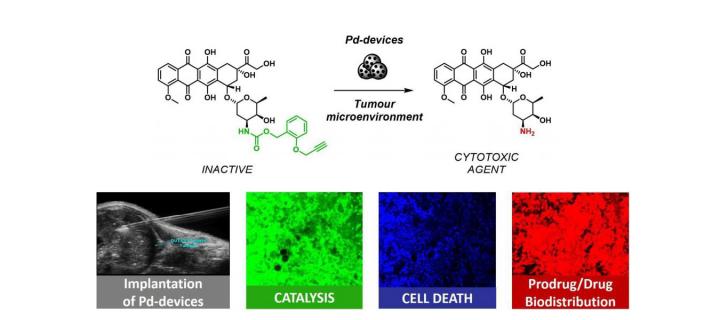Palladium mediated catalysis works in preclinical mouse model
Using advanced preclinical mouse model of prostate cancer, Cancer Research UK Edinburgh Centre scientists demonstrate potential utility of palladium nanoparticles for localised drug delivery in cancer therapy: July 2018

Production of biologically active drugs from harmless chemical compounds (prodrugs) in direct proximity of a tumour could be of great benefit in cancer therapy where cytotoxic drugs distributed in the whole body often target not only tumour site but also healthy tissues and organs causing a range of adverse effects (e.g. fatigue, nausea, hair loss). It is believed that ability to precisely control activity of cytotoxic agents would not only increase effectiveness of chemotherapy but would also prevent many of its site-effects and so reduce patients suffering.
The Innovative Therapeutics Group led by Professor Asier Unciti-Broceta in the Cancer Research UK Edinburgh Centre are world leaders in developing prodrug activation strategies based on catalytic reactions mediated by transition metals such as palladium and gold (so called bioorthogonal organometallic reactions). They not only pioneered this field of research, but were also the first ones to describe reaction of this type to be locally performed in the brain of a living animal.
In their latest study entitled “Bright insights into Palladium-triggered local chemotherapy”, just published in Chemical Science – a journal of the Royal Society of Chemistry, the Group and their collaborators from the Beatson Institute used state-of-the-art cancer models to provide fundamental new insights into insertion protocols, safety and stability of palladium-based catalytic devices.
They synthesised novel prodrugs of commonly used cytotoxic drug doxorubicin and demonstrated that these prodrugs can be efficiently activated by devices containing palladium nanoparticles. Importantly, they were also able to develop palladium-nanoparticles-containing devices with highly optimised performance and, using an advanced murine model of human prostate cancer, demonstrate that these devices can be delivered in vivo using clinically relevant methodology (ultrasound guided insertion) and retain their activity over prolonged periods of time without any detectable unfavourable effects.
This work represents an important step in preclinical development of bioorthogonal organometallic approaches and may speed up their transition into clinical trials.
Related Links
Innovative Therapeutics Group web page: https://www.ed.ac.uk/cancer-centre/research/unciti-broceta-group
Article in “Chemical Science”: https://pubs.rsc.org/en/content/articlelanding/2018/sc/c8sc02291g#!divAbstract
“Gold-Triggered Uncaging Chemistry in Living Systems Opens New Frontiers for Cancer Therapy”: https://www.ed.ac.uk/cancer-centre/news-and-events/latest-news/1-58m-career-development-fellowship
Information about prostate cancer: https://www.cancerresearchuk.org/about-cancer/prostate-cancer
General information about nanoparticles: https://en.wikipedia.org/wiki/Nanoparticle

